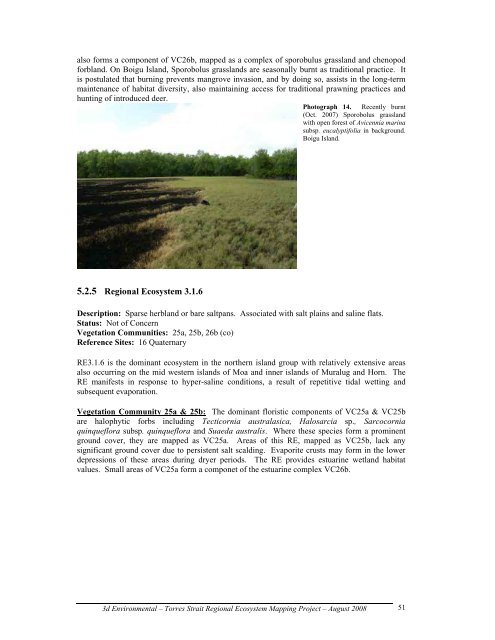Appendix 2 - Vegetation Communities and Regional Ecosystems
Appendix 2 - Vegetation Communities and Regional Ecosystems
Appendix 2 - Vegetation Communities and Regional Ecosystems
You also want an ePaper? Increase the reach of your titles
YUMPU automatically turns print PDFs into web optimized ePapers that Google loves.
also forms a component of VC26b, mapped as a complex of sporobulus grassl<strong>and</strong> <strong>and</strong> chenopod<br />
forbl<strong>and</strong>. On Boigu Isl<strong>and</strong>, Sporobolus grassl<strong>and</strong>s are seasonally burnt as traditional practice. It<br />
is postulated that burning prevents mangrove invasion, <strong>and</strong> by doing so, assists in the long-term<br />
maintenance of habitat diversity, also maintaining access for traditional prawning practices <strong>and</strong><br />
hunting of introduced deer.<br />
Photograph 14. Recently burnt<br />
(Oct. 2007) Sporobolus grassl<strong>and</strong><br />
with open forest of Avicennia marina<br />
subsp. eucalyptifolia in background.<br />
Boigu Isl<strong>and</strong>.<br />
5.2.5 <strong>Regional</strong> Ecosystem 3.1.6<br />
Description: Sparse herbl<strong>and</strong> or bare saltpans. Associated with salt plains <strong>and</strong> saline flats.<br />
Status: Not of Concern<br />
<strong>Vegetation</strong> <strong>Communities</strong>: 25a, 25b, 26b (co)<br />
Reference Sites: 16 Quaternary<br />
RE3.1.6 is the dominant ecosystem in the northern isl<strong>and</strong> group with relatively extensive areas<br />
also occurring on the mid western isl<strong>and</strong>s of Moa <strong>and</strong> inner isl<strong>and</strong>s of Muralug <strong>and</strong> Horn. The<br />
RE manifests in response to hyper-saline conditions, a result of repetitive tidal wetting <strong>and</strong><br />
subsequent evaporation.<br />
<strong>Vegetation</strong> Community 25a & 25b: The dominant floristic components of VC25a & VC25b<br />
are halophytic forbs including Tecticornia australasica, Halosarcia sp., Sarcocornia<br />
quinqueflora subsp. quinqueflora <strong>and</strong> Suaeda australis. Where these species form a prominent<br />
ground cover, they are mapped as VC25a. Areas of this RE, mapped as VC25b, lack any<br />
significant ground cover due to persistent salt scalding. Evaporite crusts may form in the lower<br />
depressions of these areas during dryer periods. The RE provides estuarine wetl<strong>and</strong> habitat<br />
values. Small areas of VC25a form a componet of the estuarine complex VC26b.<br />
3d Environmental – Torres Strait <strong>Regional</strong> Ecosystem Mapping Project – August 2008<br />
51


